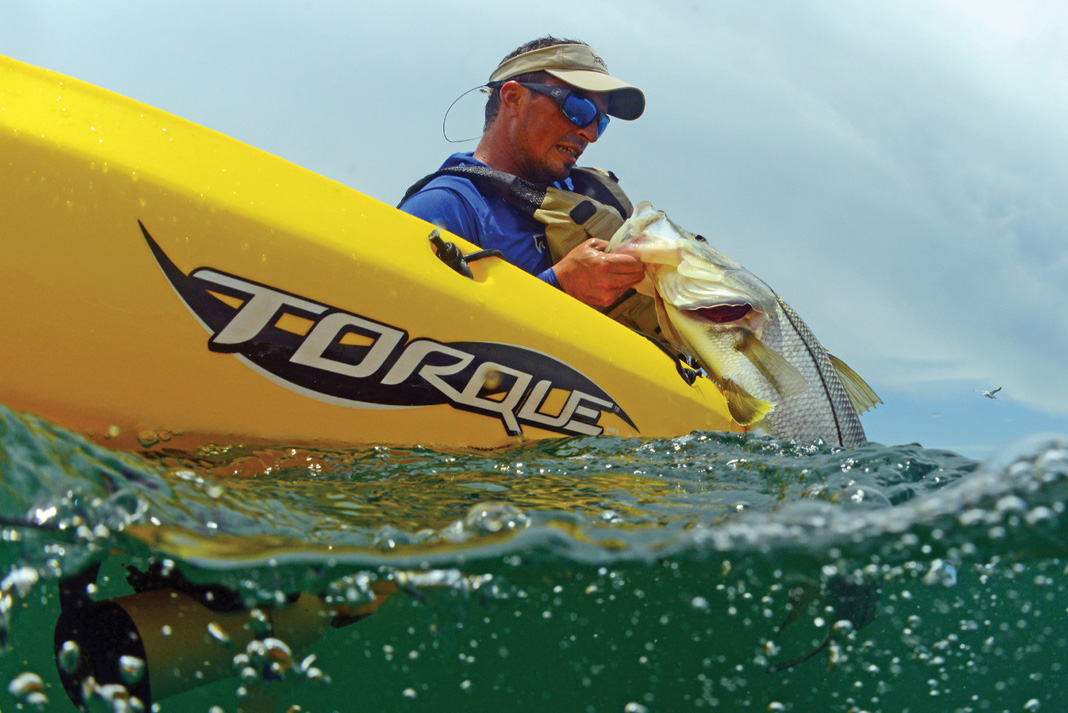The pedal revolution started more than 20 years ago when engineers at Hobie were pondering a better way to power a kayak. After trial and error, they settled on an innovative pedal drive system on top linked to swinging fins below the surface.
“You have a lot more power available in your lower body, your hands are free to fish and you do not get dripped on by the paddle,” are some of the advantages Hobie engineer George Ketterman remembers considering. The hand-free pedal-powered systems were an immediate hit with fishermen.
The motor-driven kayak movement came next, with inventive anglers adding trolling motors to their paddle boats. Ten years ago, shade-tree engineer Steve Komarinetz started building aftermarket motor kits in his garage. That project turned into Bassyaks.com, which offers electric troll- ing motor kits that pair with almost every kayak brand.
“We’re backlogged five to six weeks and we ship all over the world,” Ko- marinetz says. He adds that motor-powered boats appeal to older anglers, “They’ve got more money and sometimes less physical ability.” He says his systems also appeal to anglers more interested in fishing than paddling.
Today, a half-dozen kayak companies offer pedal-powered and motor- driven boats. “In 10 years I’ve gone from the biggest frog in the pond to almost every manufacturer offering a motorized kayak,” says Komarinetz.
Native Kayaks was an early adopter of the pedal and motor movement. In 2007, they added both a motor drive and their own take on a pedal drive system. Native’s Propel pedal system uses a bicycle-style crank and pedals to drive a propeller. The big advantage? When you pedal backwards the Native’s Propel prop also goes in reverse. And so does the kayak.
“We didn’t even realize that was going to be the biggest selling point until the boats hit the market,” remembers Native’s marketing director, Woody Calloway.

Like most consumer electronics, the motor drive revolution for kayak fishermen has benefited from giant leaps forward in battery technology. Lithium batteries are a fraction the weight and size of 12-volt marine batteries and brushless motors make the kayak propulsion units smaller, lighter and more powerful.
German-based Torqeedo’s Ultralight motor can be installed on any kayak. The highly sophisticated compact technology has caught the attention of the big boys.
Confluence Outdoor is set to release the Perception Pescador Pi- lot, the industry’s least expensive pedal drive system, and the new Wilderness Systems Helix PD pedal drive, and the Helix MD mo- tor drive, which also uses the Torqeedo motor technology. “The Torqeedo system supported our vision of a lightweight and power- ful motor drive,” explains Wildy’s product manager, Scott Stewart. “The propeller is specially designed to power a kayak.”
Hobie also uses a Torqeedo system in their Evolve motor system. The Torqeedo motor and battery are compact enough to be combined in one unit that fits into any MirageDrive kayak. Many of Hobie’s models can be paddled, pedaled, motored or sailed.
“There’s something holistic in using clean energy, the wind or the body to power a kayak,” explains brand manager, Keeton Eoff. “We want to offer the user the best experience with options that meet their core needs.”
Johnson Outdoors, which owns Old Town Canoes and Kayaks and Ocean Kayak, first shocked the kayak world with the electric mo- tor-powered Torque featuring a removable outdrive molded into the kayak hull. After the Torque, the company went a different route for its next generation of alternative-powered kayaks.
Instead of building a do-it-all boat with interchangeable compo- nents, Old Town designed a separate pedal-driven boat and a motor- powered kayak. “Each type of boat has different design requirements and appeals to a different type of angler,” says David Hadden, brand manager at Old Town.
Partnering with sister company, and trolling motor giant Minn Kota, the engineers at Old Town developed the Predator XL Minn Kota. “We worked directly with engineers from Minn Kota to de- sign a drive specific for a motor kayak,” Hadden says.
This past summer at ICAST, Old Town revealed their pedal-driv- en Predator PDL kayak addition to their awarding-winning fishing platform. “The boat is designed from the water up for pedaling,” Hadden says. “The seat is at the optimal height, the hull is built to reduce noise and the cockpit is set up to accept the pedals.”
After two decades leading alternative-power paddlecraft solu- tions, Hobie continues to innovate. The biggest news in kayak fish- ing to light up Kayak Angler’s social media channels in 2016 was our sneak peek at Hobie’s new MirageDrive 180.
“This year we’ve added reverse to our MirageDrive,” says Eoff, adding that Hobie’s swept-fin design is more efficient and power- ful than many traditional propellers. “The beauty is, in reverse or forward, anglers don’t lose power.”
The next trend in alternative-powered kayaks seems like it may be the combining of both alternative power sources in one unit. At this past summer’s major industry trade shows both Feelfree and Jackson Kayak displayed their own prototype drive units powered by pedal or motor. By next spring, kayak anglers may be able to push a button and go from leg power to battery power on the fly.
Consumer interest and technological advancement are challeng- ing manufacturers to develop new alternatives. So what’s next? Most important of all says Hobie’s Eoff, “Expect technology to continue to improve the kayak fishing experience.”






